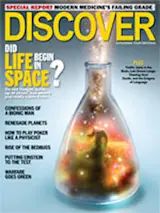In the latest scientific version of Genesis, life begins, paradoxically, with an act of destruction. After 10 billion years of guzzling the hydrogen in its core, a sun-size star runs out of nuclear fuel and becomes unstable. It goes through a series of convulsions and expels a shell of searing-hot atoms—including hydrogen, carbon, and oxygen. The star fizzles into an inert cinder, and its atoms drift off, seemingly lost in the interstellar gloom.
But next the story takes a surprise turn, from destruction to construction. Some of those rogue atoms float into a nearby gas cloud and stick to fine grains of dust there. Even at a frigid –440 degrees Fahrenheit, the atoms bump and crash into each other, merging to form simple molecules. Over millions of years, one relatively dense region of the cloud begins to collapse in on itself. An infant star takes shape at the center. In ...














